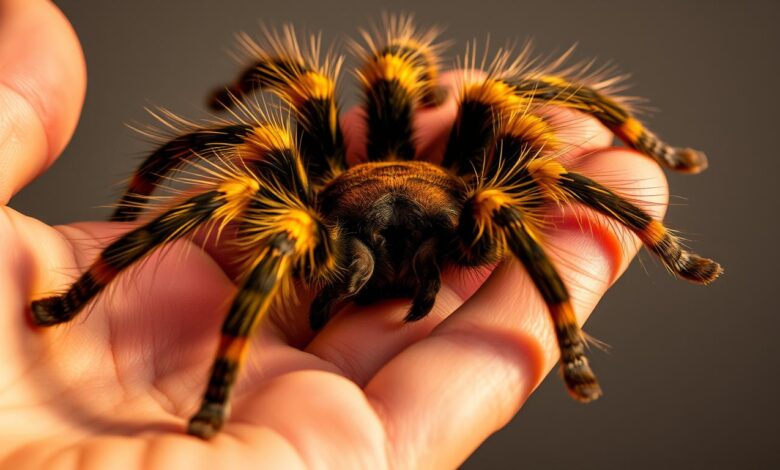Is it safe to let a tarantula crawl on you?

Tarantulas are big, hairy spiders that can fascinate us. They have a docile temperament, but their bites can hurt if not handled right. It’s key to know the risks and take safety steps.
For those scared of spiders, the idea of touching a tarantula might seem scary. But, with slow steps and getting used to them, you can learn to like them. Handling tarantulas right means knowing their needs and how to keep them safe.
If you love bugs or want to learn about exotic pets, knowing how to handle tarantulas is important. By focusing on safety for both you and the tarantula, you can have a fun and educational experience. This will help you appreciate these amazing spiders more.
Common Fears and Misconceptions about Tarantulas
Many people fear or dislike tarantulas because of myths. It’s key to clear up these misconceptions. This way, we can understand tarantulas better and fight the fear of arachnophobia.
Overcoming Arachnophobia
The fear of tarantulas often comes from their size and hairiness. But, tarantulas are not usually aggressive towards humans. Their venom is also not a big deal medically. With the right steps, people can learn to like tarantulas and beat their fears.
Experts say to start slowly with tarantulas and learn about them. This helps build confidence. Safe, supervised interactions can change how people see tarantulas for the better.
- Common fears about tarantulas include their size, appearance, and perceived aggression.
- Tarantulas are not inherently aggressive and their venom is generally not a threat to humans.
- Gradual exposure, education, and building confidence through controlled interactions can help overcome arachnophobia.
By facing these fears and myths, we can appreciate tarantulas more. Some might even want to try tarantula handling for beginners to face and beat their fears.
Tarantula Temperament and Behavior
Many people think tarantulas are scary, but most are actually calm and gentle. They usually don’t attack unless they’re scared or threatened. Tarantulas use their hairs and warning signs to defend themselves, biting only when they must.
But, not all tarantulas are the same. Some, like the Poecilotheria, are more defensive and might bite if you touch them. It’s important to know how different tarantulas behave to keep them and yourself safe.
Tarantula fans often group them into two types based on how they act:
- Docile Tarantulas: These are calm and gentle, perfect for people who know how to handle them. They don’t get aggressive easily and might even enjoy being touched a little.
- Defensive Tarantulas: These tarantulas get scared easily and might show their defenses or bite when threatened. They need careful handling and are best left to experts.
Knowing how different tarantulas act helps owners have a good time with them. It’s all about being careful and understanding each tarantula’s unique needs and personality.
Tarantula Safety Precautions
Handling tarantulas safely is key. Always wear thick gloves to protect your hands. Move slowly and carefully around them to avoid startling them.
By using proper tarantula handling techniques, you can reduce stress and the chance of a bite. This includes gently cupping the spider or letting it walk on your arm.
First Aid for Tarantula Bites
If you get bitten by a tarantula, act fast. First, clean the wound with soap and water to prevent infection. Then, use a cold compress or ice pack to reduce swelling and pain.
If the bite looks bad or you have trouble breathing, get medical help right away. Knowing how to safely handle tarantulas and deal with tarantula bites lets you enjoy them while staying safe.
Is it safe to let a tarantula crawl on you?
Letting a tarantula crawl on you might seem exciting, but it’s important to think about the risks and benefits first. Tarantulas are usually calm, but they can bite if scared. This is something to consider, especially if you’re afraid of spiders.
Some people enjoy the feeling of a spider on their skin. It can help them get over their fear and appreciate these creatures more. But, it’s key to make sure both the spider and the person are safe and comfortable.
Deciding to let a tarantula crawl on you should be a careful choice. Make sure the spider is calm and you’re okay with it. With the right care and respect, it can be a safe and rewarding experience.
Exotic Pet Interactions: Benefits and Risks
Interacting with exotic pets like tarantulas can be exciting and rewarding. These unique creatures let us learn about their fascinating behaviors and characteristics. This can deepen our connection with nature. But, it’s important to know that these interactions also come with risks.
The benefits of interacting with exotic pets are many. For example, handling a tarantula lets you see its delicate movements and intricate anatomy up close. This can spark a sense of wonder and respect for these animals. Plus, it can be educational, teaching us about their habitats, feeding habits, and social dynamics.
However, the risks of interacting with exotic pets should not be ignored. Tarantulas, even though they are gentle, can bite painfully if they feel threatened or are handled wrong. There’s also the chance of getting scratched, having an allergic reaction, or even getting sick from zoonotic diseases. It’s important to be well-informed, take safety precautions, and respect the animal’s well-being.
When handling exotic pets safely, knowing the specific species and its temperament is key. Move slowly and calmly when interacting with tarantulas or other exotic pets. Wearing thick gloves can also help reduce risks. Making the decision to interact with these pets should be thoughtful, considering both the benefits and risks.
Understanding the complexities of exotic pet interactions helps us make safer choices. By balancing the allure of these creatures with necessary precautions, we can have a rewarding and responsible experience. This way, we can enjoy the wonders of the natural world while keeping everyone safe.
Responsible Tarantula Ownership
Owning a tarantula as a pet is rewarding but demanding. Before getting one, you must research the specific care needs of your chosen species. It’s important to provide the right housing, substrate, temperature, and humidity.
Proper Housing and Care
Tarantulas need special enclosures for burrowing and hiding. They also need proper feeding, water, and monitoring for health issues. Knowing the tarantula care requirements is key to keeping your pet tarantula happy and healthy.
Here are some important tips for proper tarantula housing and care:
- Choose an enclosure that fits your tarantula’s needs and behaviors.
- Use the right substrate for burrowing and humidity.
- Keep the temperature and lighting right to mimic their natural habitat.
- Make sure they have reliable water and follow a feeding schedule.
- Watch for signs of stress or illness and seek vet help if needed.
By following these responsible tarantula ownership tips, you can create a safe and happy home for your tarantula.
Insights from Tarantula Enthusiasts
We explore the world of tarantulas, thanks to passionate enthusiasts. They share their deep understanding and care for these arachnids. Their hands-on experience gives a unique view on the joys and challenges of tarantula interactions.
These enthusiasts love watching tarantulas and know how to respect their needs. Their stories and tips are great for anyone interested in tarantulas. This includes those who want to keep them as pets or just enjoy watching them.
Emily, a seasoned tarantula keeper, talks about handling them right. “Tarantulas are not aggressive but can be defensive if scared. It’s key to handle them calmly and gently, letting them get used to you before touching.”
David, a frequent tarantula exhibit visitor, stresses patience and respect. “Tarantulas have their own personalities. By watching their behavior and respecting them, I have rewarding experiences. It makes me appreciate these amazing creatures even more.”
| Key Insights from Tarantula Enthusiasts |
|---|
|
These enthusiasts offer great advice for exploring tarantulas. By following their tips and being respectful, you can start a rewarding journey. You’ll discover the beauty and complexity of tarantulas.
Species-Specific Considerations
Not all tarantulas are the same when it comes to being pets. Some, like those in the Brachypelma and Aphonopelma genera, are easy-going and fun to handle. But others can be quite defensive and might even get aggressive.
Docile vs. Defensive Tarantulas
For example, Poecilotheria (Ornamental Tree Spiders) and Psalmopoeus (Avicularia) are not as good for handling. They tend to be more defensive and might show threat signs, flick hairs, or even bite when scared. It’s key to know what each species needs and how to handle them safely.
Knowing the different temperaments of tarantulas helps you pick the right one for you. Looking into tarantula species can guide you to a great pet experience. It’s all about finding the right match for a fun and safe time with these amazing creatures.



